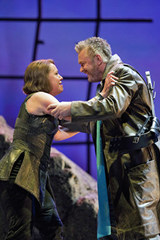| Opera Reviews | 25 April 2024 |
The Ring ends with more powerful imageryby Michael J. Vaughn |
|
| Wagner: Götterdämmerung San Francisco Opera 19 June 2011 |
|
|
The thread begins with cables - in fact, piles of them, a high-tech substitute for the rope of fate. With Wotan bringing the gods to their end, the Norns - dressed in the surgeon-style scrubs of Silicon Valley clean rooms - are unable to save the universal connections from a system crash. Former SFO Adler Fellow Daveda Karanas stands out as the Second Norn, and also, later, as Brünnhilde's Valkyrie sister Waltraute. Tenor Ian Storey makes an apt successor to Siegfried's Siegfried, Jay Hunter Morris - physically, they almost look related. Unfortunately, Storey also carried on with Morris's vocal struggles. Such was his plight in Act II that general director David Gockley appeared to ask for the audience's understanding. Freed up by a physician's clearance and license to go ahead and clear his throat, Storey made a heroic comeback, performing Siegfried's final monologue with a touching pathos. The new ring-pirates, the Gibichungs, plan their attack from set designer Michael Yeargan's steel-and-glass industrial headquarters. Their demeanor and clothing, however, smack more of tabloid Hollywood, Gutrune and her dazzling gowns like a cousin to Paris Hilton and Kim Kardashian. Although the plot devices at this point begin to spiral out of control (notably the love potion that sends Siegfried into the arms of Gutrune), the production is carried through by some remarkable performances. Nina Stemme continues her role as a force of nature, bringing such vigor to Brünnhilde that one worries for her health. Bass Andrea Silvestrelli milks the prime conspirator, Hagen (or, as we call him, Karl Rove), for every ounce of nastiness. The men's chorus gives a stirring (and somewhat frightening) performance as Hagen's fascists-in-waiting in "Gross Gluck und Heil". The Rhinemaidens - Stacey Tappan, Lauren McNeese and Renee Tatum - return to pull the plastic bottles out of the River not-so-Gold and offer three-part laments that make you wish Wagner had done more of such work. What really shines through in the totality of this Ring, however, is the playing of Donald Runnicles and his orchestra. Played so beautifully, Wagner's motifs have a way of rewiring one's circuitry and returning over the following weeks for haunting internal replays. The company's rendition of the finale is spectacular, Brünnhilde's immolation causing an image-burst of the soldier-photos that populated the Valhalla of Die Walküre. I still won't forgive Wagner for this act and others (notably the lame attempt at reforming Gutrune), which show signs of a man who has painted his narrative into a corner and is desperately tying up his ends. But the powerful imagery of Zambello's conception certainly makes up for a lot. |
|
| Michael J. Vaughn is a 25-year opera critic and the author of the novel/CD "Operaville," available at amazon.com. | |
| Text ©
Michael J. Vaughn Photos © Cory Weaver |

 The
industrial imagery that underlies Francesca Zambello's American Ring
Cycle comes to a head in Götterdämmerung, as the mortals
take over for the gods in the process of screwing with nature. The interlude
projections of pollution and refineries threatens, in fact, to become
overbearing, except when one realizes how overt this theme is in the
text. Wagner and his source mythologies were nothing if not sadly prescient.
The
industrial imagery that underlies Francesca Zambello's American Ring
Cycle comes to a head in Götterdämmerung, as the mortals
take over for the gods in the process of screwing with nature. The interlude
projections of pollution and refineries threatens, in fact, to become
overbearing, except when one realizes how overt this theme is in the
text. Wagner and his source mythologies were nothing if not sadly prescient.






